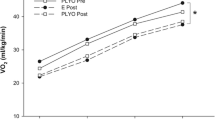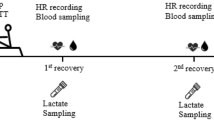Abstract
This report describes the changes in physiological capacity of a heavy-weight rower who obtained seven medals in World Championships and Olympic Games. The investigation was carried out over the last 6 years of the rower’s international competition career in comparison with peer champions, and the following 4 years. Over the first period, maximal oxygen uptake (\( \dot{V}{\text{O}}_{2\max } \)) remained above 6 l min−1 which is an outstanding value. The training load measured over the last 18 months of the period increased from 119 to 142 km wk−1 of rowing. Four years after the international competition period, \( \dot{V}{\text{O}}_{2\max } \) had only declined by 3.6% although the training load had declined by 35%. These data suggest that the ability of this rower to compete at top level for years was related to ability to maintain an outstanding \( \dot{V}{\text{O}}_{2\max } \). Gross efficiency and ability to rely on anaerobic glycolysis did not emerge as relevant factors.


Similar content being viewed by others
References
Booth FW, Thomason DB (1991) Molecular and cellular adaptation of muscle in response to exercise: perspectives of various models. Physiol Rev 71:541–585
Bouchard C, Daw EW, Rice T, Pérusse L, Gagnon J, Province MA, Leon AS, Rao DC, SKinner JS, Wilmore JH (1998) Familial resemblance for VO2 max in the sedentary state: the HERITAGE family study. Med Sci Sports Exerc 30:252–258. doi:10.1097/00005768-199802000-00013
Bourdin M, Messonnier L, Hager J-P, Lacour J-R (2004a) Peak power output predicts rowing ergometer performance in elite male rowers. Int J Sports Med 25:368–373. doi:10.1055/s-2004-815844
Bourdin M, Messonnier L, Lacour J (2004b) Laboratory blood lactate profile is suited to on water training monitoring in highly trained rowers. J Sports Med Phys Fitness 44:337–341
Chesley A, Heigenhauser GJ, Spriet LL (1996) Regulation of muscle glycogen phosphorylase activity following short-term endurance training. Am J Physiol 270:E328–E335
Coyle EF (2005) Improved muscular efficiency displayed as Tour de France champion matures. J Appl Physiol 98:2191–2196. doi:10.1152/japplphysiol.00216.2005
Daniels JT (1974) Running with Jim Ryun: a five-year study. Phys Sportsmed 2:62–67
Donato AJ, Tench K, Glueck DH, Seals DR, Eskurza I, Tanaka H (2003) Declines in physiological functional capacity with age: a longitudinal study in peak swimming performance. J Appl Physiol 94:764–769. doi:10.1063/1.1581376
Evans S, Davy K, Stevenson E, Seals D (1995) Physiological determinants of 10-km performance in highly trained female runners of different ages. J Appl Physiol 78:1931–1941
Gormley SE, Swain DP, High R, Spina RJ, Dowling EA, Kotipalli US, Gandrakota R (2008) Effect of Intensity of Aerobic Training on VO2 max. Med Sci Sports Exerc 40:1336–1343. doi:10.1249/MSS.0b013e31816c4839
Hagerman FC, Fielding RA, Fiatarone MA, Gault JA, Kirkendall DT, Ragg KE, Evans WJ (1996) A 20-year longitudinal study of olympic oarsmen. Med Sci Sports Exerc 28:1150–1156. doi:10.1097/00005768-199609000-00011
Hawley JA, Noakes TD (1992) Peak power output predicts maximal oxygen uptake and performance time in trained cyclists. Eur J Appl Physiol 65:79–83. doi:10.1007/BF01466278
Heath GW, Hagberg JM, Ehsani AA, Holloszy JO (1981) A physiological comparison of young and older endurance athletes. J Appl Physiol 51:634–640
Ivy J, Withers R, Handel PV, Elger D, Costill D (1980) Muscle respiratory capacity and fiber type as determinant of the lactate threshold. J Appl Physiol 48:523–527
Jones AM (1998) A five year physiological case study of an Olympic runner. Br J Sports Med 32:39–43. doi:10.1136/bjsm.32.1.39
Kuipers H, Verstappen FTJ, Keizer HA, Geurten P, vanKranenburg G (1985) Variability of aerobic performance in the laboratory and its physiologic correlates. Int J Sports Med 6:197–200. doi:10.1055/s-2008-1025839
Lacour JR, Messonnier L, Bourdin M (2007) The leveling-off of oxygen uptake is related to blood lactate accumulation. Retrospective study of 94 elite rowers. Eur J Appl Physiol 101:241–247. doi:10.1007/s00421-007-0487-7
Marti B, Howald H (1990) Long-term effects of physical training on aerobic capacity: controlled study of former elite athletes. J Appl Physiol 69:1451–1459
McConell GK, Costill DL, Widrick JJ, Hickey MS, Tanaka H, Gastin PB (1993) Reduced training volume and intensity maintain aerobic capacity but not performance in distance runners. Int J Sports Med 14:33–37. doi:10.1055/s-2007-1021142
Messonnier L, Freund H, Bourdin M, Belli A, Lacour J-R (1997) Lactate exchange and removal abilities in rowing performance. Med Sci Sports Exerc 29:396–401. doi:10.1097/00005768-199703000-00016
Messonnier L, Bourdin M, Lacour J-R (1998) Influence of age on different determining factors of performance on rowing ergometer. Sci Sports 13:293–294. doi:10.1016/S0765-1597(99)80011-2
Messonnier L, Aranda-Berthouze SE, Bourdin M, Bredel Y, Lacour JR (2005) Rowing performance and estimated training load. Int J Sports Med 26:376–382. doi:10.1055/s-2004-821051
Noakes TD, Myburgh KH, Schall R (1990) Peak treadmill running velocity during the VO2max test predicts running performance. J Sports Sci 8:35–45
Padilla S, Mujika I, Angulo F, Goiriena JJ (2000) Scientific approach to the 1-h cycling world record: a case study. J Appl Physiol 89:1522–1527
Peronnet F, Morton RH (1994) Plasma lactate concentration increases as a parabola with delay during ramp exercise. Eur J Appl Physiol 68:228–233. doi:10.1007/BF00376771
Pilegaard H, Bangsbo J, Richter EA, Juel C (1994) Lactate transport studied in sarcolemmal giant vesicles from human muscle biopsies: relation to training status. J Appl Physiol 77:1858–1862
Rusko H (1987) The effect of training on aerobic power characteristics of young cross-country skiers. J Sports Sci 5:273–286
Saltin B (1986) The aging endurance athlete. In: Sutton J, Brock R (eds) Sports Medicine for the mature athlete. Benchmark, Indianapolis, pp 59–80
Schabort EJ, Hawley JA, Hopkins WG, Blum H (1999) High reliability of performance of well-trained rowers on a rowing ergometer. J Sports Sci 17:627–632. doi:10.1080/026404199365650
Secher N, Espersen M, Binkhorst R, Andersen P, Rube N (1982) Aerobic power at the onset of maximal exercise. Scand J Sports Sci 4:12–16
Snoeckx L, Abeling H, Lambregts J, Schmitz J, Verstappen F, Reneman R (1983) Cardiac dimensions in athletes in relation to variations in their training program. Eur J Appl Physiol 52:20–28. doi:10.1007/BF00429020
Tanaka H, Seals D (1997) Age and gender interactions in physiological functional capacity: insight from swimming performance. J Appl Physiol 82:846–851
Acknowledgment
The authors thank Jean-Christophe Rolland for his collaboration in this study. The results of the present study do not constitute endorsement by ACSM.
Author information
Authors and Affiliations
Corresponding author
Rights and permissions
About this article
Cite this article
Lacour, JR., Messonnier, L. & Bourdin, M. Physiological correlates of performance. Case study of a world-class rower. Eur J Appl Physiol 106, 407–413 (2009). https://doi.org/10.1007/s00421-009-1028-3
Accepted:
Published:
Issue Date:
DOI: https://doi.org/10.1007/s00421-009-1028-3




